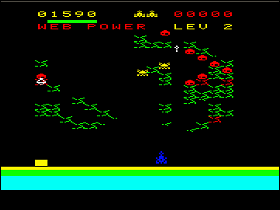 The Game: Spiders slink down from the top of the screen, constructing an elaborate web and laying eggs as they go. The player, manning a mobile bug-blasting cannon, can take out the spiders, but the eggs are still gestating and will hatch new spiders unless they’re destroyed; new spiders repeat the cycle in rapid succession. Spiders will manage to build their web to the bottom of the screen, restricting the cannon’s movement (and creating zones of the screen where future spider hatchlings can move unimpeded). The game ends when the player loses all of the cannons to the spiders or their incoming fire. (Emerson, 1982)
The Game: Spiders slink down from the top of the screen, constructing an elaborate web and laying eggs as they go. The player, manning a mobile bug-blasting cannon, can take out the spiders, but the eggs are still gestating and will hatch new spiders unless they’re destroyed; new spiders repeat the cycle in rapid succession. Spiders will manage to build their web to the bottom of the screen, restricting the cannon’s movement (and creating zones of the screen where future spider hatchlings can move unimpeded). The game ends when the player loses all of the cannons to the spiders or their incoming fire. (Emerson, 1982)
Memories: In this early epoch of the video game industry, there seemed to be a perception that you simply weren’t taking things seriously unless you secured an arcade license. Witness the Odyssey², whose sole first-party licensed arcade port came too late in the machine’s library to bolster its popularity, or the Intellivision, which avoided arcade ports at first and then broke through to widespread popularity with a licensed home version of Burgertime.
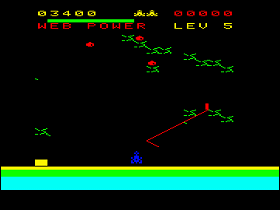 Not wanting to be a casualty of the video game wars, Emerson landed a handful of relatively obscure arcade licenses such as Jungler, Funky Fish and Spiders – none of them exactly household names in the coin-op world. (Most people probably can’t even remember seeing these games in the arcade at all; the author of this review barely remembers seeing Spiders and Jungler in the flesh.) Spiders was actually this vague and abstract in the arcade, too, so it’s really not a bad port, especially on the Arcadia 2001.
Not wanting to be a casualty of the video game wars, Emerson landed a handful of relatively obscure arcade licenses such as Jungler, Funky Fish and Spiders – none of them exactly household names in the coin-op world. (Most people probably can’t even remember seeing these games in the arcade at all; the author of this review barely remembers seeing Spiders and Jungler in the flesh.) Spiders was actually this vague and abstract in the arcade, too, so it’s really not a bad port, especially on the Arcadia 2001.
 For such an obscure arcade game, Spiders got around; there was also a fairly entertaining Entex tabletop game, though its matrix of fixed graphics made it much more difficult to figure out what was going on. The Arcadia version is fairly faithful to the original, duplicating the utter strangeness of the coin-op original nicely.
For such an obscure arcade game, Spiders got around; there was also a fairly entertaining Entex tabletop game, though its matrix of fixed graphics made it much more difficult to figure out what was going on. The Arcadia version is fairly faithful to the original, duplicating the utter strangeness of the coin-op original nicely.
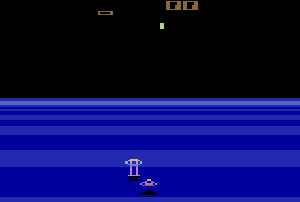
 The Game: As the pilot of a super-fast intergalactic rescue ship (which is also armed to the teeth, which explains the absence of a red cross painted on the hull), you must navigate your way through hazardous comets and space debris, entering low orbit around various planets from which you must rescue a certain number of stranded civilians. But there’s a reason you’re armed – some alien thugs mean to keep those people stranded, and will do their best to blast you into dust. You can return the favor, and after you rescue the needed quota of people from the surface, you must align your ship with a series of launch rings to reach orbit again. (Imagic, 1982)
The Game: As the pilot of a super-fast intergalactic rescue ship (which is also armed to the teeth, which explains the absence of a red cross painted on the hull), you must navigate your way through hazardous comets and space debris, entering low orbit around various planets from which you must rescue a certain number of stranded civilians. But there’s a reason you’re armed – some alien thugs mean to keep those people stranded, and will do their best to blast you into dust. You can return the favor, and after you rescue the needed quota of people from the surface, you must align your ship with a series of launch rings to reach orbit again. (Imagic, 1982)
 The Game: In this munching-maze game, you control a mouse who scurries around a cheese-filled maze which can only be navigated by strategically opening and closing yellow, red and blue doors with their color-coded buttons. Occasionally a big chunk o’ cheese can be gobbled for extra points. Is it that easy? No. There is also a herd of hungry kitties who would love a mousy morsel. But you’re not defenseless. By eating a bone, you can transform into a dog, capable of eating the cats. But each bone’s effects only last for a little while, after which you revert to a defenseless mouse. (Coleco, 1982)
The Game: In this munching-maze game, you control a mouse who scurries around a cheese-filled maze which can only be navigated by strategically opening and closing yellow, red and blue doors with their color-coded buttons. Occasionally a big chunk o’ cheese can be gobbled for extra points. Is it that easy? No. There is also a herd of hungry kitties who would love a mousy morsel. But you’re not defenseless. By eating a bone, you can transform into a dog, capable of eating the cats. But each bone’s effects only last for a little while, after which you revert to a defenseless mouse. (Coleco, 1982)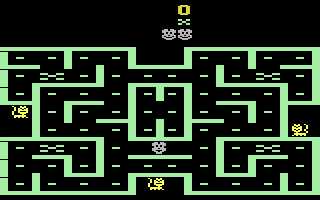 The Game: In this munching-maze game (one of the dozens of such games which popped up in the wake of Pac-Man), you control a cartoonish mouse who scurries around a cheese-filled maze which can only be navigated by strategically opening and closing doors in the maze. Occasionally a big chunk o’ cheese can be gobbled for extra points. Is it that easy? No. There is also a herd of hungry kitties who would love a mousy morsel. But you’re not defenseless. By eating a bone (the equivalent of Pac-Man’s power pellets), you can transform into a dog, capable of eating the cats. But each bone’s effects only last for a little while, after which you revert to a defenseless mouse. (Coleco, 1982)
The Game: In this munching-maze game (one of the dozens of such games which popped up in the wake of Pac-Man), you control a cartoonish mouse who scurries around a cheese-filled maze which can only be navigated by strategically opening and closing doors in the maze. Occasionally a big chunk o’ cheese can be gobbled for extra points. Is it that easy? No. There is also a herd of hungry kitties who would love a mousy morsel. But you’re not defenseless. By eating a bone (the equivalent of Pac-Man’s power pellets), you can transform into a dog, capable of eating the cats. But each bone’s effects only last for a little while, after which you revert to a defenseless mouse. (Coleco, 1982)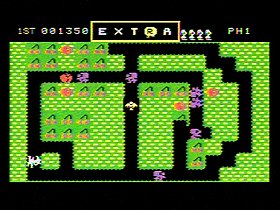 The Game: As an elfin dweller of a magic garden, you must avoid or do away with a bunch of nasty critters who are after you, while gobbling up
The Game: As an elfin dweller of a magic garden, you must avoid or do away with a bunch of nasty critters who are after you, while gobbling up 
 The Game: You are NED, hopping over boulders and, with each obstacle overcome, tackling progressively more difficult math questions and pattern-matching exercises. You can select what kind of math you need to work on (addition, subtraction, etc.), and if you don’t solve a problem correctly the first time, it’s broken down into smaller parts to help you work out how it all goes together. (North American Philips, 1982)
The Game: You are NED, hopping over boulders and, with each obstacle overcome, tackling progressively more difficult math questions and pattern-matching exercises. You can select what kind of math you need to work on (addition, subtraction, etc.), and if you don’t solve a problem correctly the first time, it’s broken down into smaller parts to help you work out how it all goes together. (North American Philips, 1982)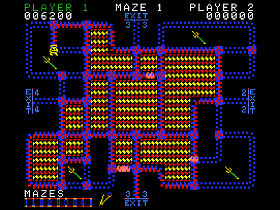 The Game: You’re a little angel (of sorts). You run around a maze consisting of zippers which close or open, depending upon whether or not you’ve already gone over that section of the maze. Zipping up one square of the maze scores points for you, but it gets trickier. Little devils chase you around the maze, trying to kill you before you can zip up the entire screen. If you zip up enough of the maze and grab a power-pellet-like object, you can dispatch some of your pursuers. Clear the screen and the fun begins anew. (Exidy, 1982)
The Game: You’re a little angel (of sorts). You run around a maze consisting of zippers which close or open, depending upon whether or not you’ve already gone over that section of the maze. Zipping up one square of the maze scores points for you, but it gets trickier. Little devils chase you around the maze, trying to kill you before you can zip up the entire screen. If you zip up enough of the maze and grab a power-pellet-like object, you can dispatch some of your pursuers. Clear the screen and the fun begins anew. (Exidy, 1982)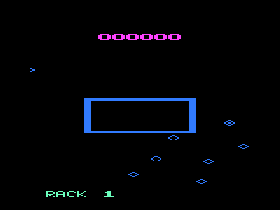 The Game: In an enclosed track in space, you pilot a sleek, lone space fighter up against an army of mine-laying opponents. In early rounds of the Omega Race, only a few minelayers activate at a time…but in later rounds, they all deploy their full arsenal at you at once, leaving you to dodge through a deadly maze in zero gravity while trying to turn to draw a bead on your opponents. You can bounce off of the walls of the track, but anything else is deadly to touch. (CBS Electronics, under license from Bally/Midway, 1982)
The Game: In an enclosed track in space, you pilot a sleek, lone space fighter up against an army of mine-laying opponents. In early rounds of the Omega Race, only a few minelayers activate at a time…but in later rounds, they all deploy their full arsenal at you at once, leaving you to dodge through a deadly maze in zero gravity while trying to turn to draw a bead on your opponents. You can bounce off of the walls of the track, but anything else is deadly to touch. (CBS Electronics, under license from Bally/Midway, 1982)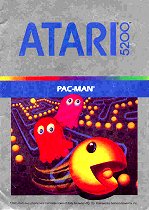 The Game: As a round yellow creature consisting of a mouth and nothing else, you maneuver around a relatively simple maze, gobbling small dots and evading four colorful monsters who can eat you on contact. In four corners of the screen, large flashing dots enable you to turn the tables and eat the monsters for a brief period for an escalating score . Periodically, assorted items appear near the center of the maze, and you can consume these for additional points as well. The monsters, once eaten, return to their home base in ghost form and return to chase you anew. If cleared of dots, the maze refills and the game starts again, but just a little bit faster… (Atari, 1982)
The Game: As a round yellow creature consisting of a mouth and nothing else, you maneuver around a relatively simple maze, gobbling small dots and evading four colorful monsters who can eat you on contact. In four corners of the screen, large flashing dots enable you to turn the tables and eat the monsters for a brief period for an escalating score . Periodically, assorted items appear near the center of the maze, and you can consume these for additional points as well. The monsters, once eaten, return to their home base in ghost form and return to chase you anew. If cleared of dots, the maze refills and the game starts again, but just a little bit faster… (Atari, 1982) The Game: The war between the humans and the spacefaring enemy Dracons isn’t going well, and you’ve enlisted to join the fight. In the cockpit of your space fighter, you toggle between your flight computer (where you can find and set a course for Dracon attack groups on the map, or helpful starbases where you can replenish and repair your ship) and the direct view ahead when you engage in combat. The Dracons throw a lot of firepower at you, but your own torpedoes have a longer “reach” than their ammo. Your ship can take a pounding in a firefight, gradually eliminating your shields, your targeting ability, and even your weapons. The game is over when you can’t withdraw for repairs and are destroyed by the Dracons. (Arcadia, 1982)
The Game: The war between the humans and the spacefaring enemy Dracons isn’t going well, and you’ve enlisted to join the fight. In the cockpit of your space fighter, you toggle between your flight computer (where you can find and set a course for Dracon attack groups on the map, or helpful starbases where you can replenish and repair your ship) and the direct view ahead when you engage in combat. The Dracons throw a lot of firepower at you, but your own torpedoes have a longer “reach” than their ammo. Your ship can take a pounding in a firefight, gradually eliminating your shields, your targeting ability, and even your weapons. The game is over when you can’t withdraw for repairs and are destroyed by the Dracons. (Arcadia, 1982)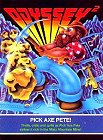 The Game: As Pete, you start out in the center of a multi-tiered mine – not at the bottom – and your boulder-smashing pick axe begins to deteriorate after about one minute. Then you either have to jump over or duck under the onslaught of falling rocks, or you’re toast. Falling to the lower levels won’t kill you, if you time it just right so as not to land right in the middle of an avalanche. When two boulders collide, they can uncover treasures such as a fresh pick axe or, more importantly, a key to the next level. As you progress through the levels, one horizontal space is deleted somewhere on the screen at random, progressing on until you have a death-trap of open space where rocks can bounce right up into your face. (North American Philips, 1982)
The Game: As Pete, you start out in the center of a multi-tiered mine – not at the bottom – and your boulder-smashing pick axe begins to deteriorate after about one minute. Then you either have to jump over or duck under the onslaught of falling rocks, or you’re toast. Falling to the lower levels won’t kill you, if you time it just right so as not to land right in the middle of an avalanche. When two boulders collide, they can uncover treasures such as a fresh pick axe or, more importantly, a key to the next level. As you progress through the levels, one horizontal space is deleted somewhere on the screen at random, progressing on until you have a death-trap of open space where rocks can bounce right up into your face. (North American Philips, 1982) The Game: You’re a mama pig trying to prevent her adorable piglets from becoming a side of bacon for a pack of big bad wolves. First, you try to shoot down as many wolves as they try to parachute to safety with balloons, and then you have to prevent them from rising back up again, because if they do, they’re going to push a big rock right off a cliff and on top of you. (Konami, 1982)
The Game: You’re a mama pig trying to prevent her adorable piglets from becoming a side of bacon for a pack of big bad wolves. First, you try to shoot down as many wolves as they try to parachute to safety with balloons, and then you have to prevent them from rising back up again, because if they do, they’re going to push a big rock right off a cliff and on top of you. (Konami, 1982)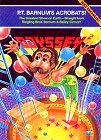 The Game: You control an acrobat on a moving see-saw, launching your fellow acrobat into the air to pop balloons and defy gravity in an act that would’ve done old Barnum proud! But what goes up must come down, and your airborne acrobat, if he doesn’t bounce upward upon impact with more balloons, will plummet at alarming speed. You have to catch him with the empty end of the see-saw, thus catapulting the other acrobat into a fresh round of inflatible destruction. (North American Philips, 1982)
The Game: You control an acrobat on a moving see-saw, launching your fellow acrobat into the air to pop balloons and defy gravity in an act that would’ve done old Barnum proud! But what goes up must come down, and your airborne acrobat, if he doesn’t bounce upward upon impact with more balloons, will plummet at alarming speed. You have to catch him with the empty end of the see-saw, thus catapulting the other acrobat into a fresh round of inflatible destruction. (North American Philips, 1982)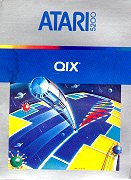 The Game: You control a “marker,” trying to claim as much of the playing field as you can by enclosing areas of it. Drawing your boundaries faster is safer, but yields fewer points. A slower draw, which leaves you vulnerable to attack from the Qix and the Sparx, gives you many more points upon the completion of an enclosed area. If the ever-shifting Qix touches your marker or an uncompleted boundary you are drawing, you lose a “life” and start again. And the Sparx, which travel only along the edges of the playing field and along the boundaries of areas of the screen you’ve already enclosed, can destroy you by touching your marker. And if you linger too long, a fuse will begin burning at the beginning of your unfinished boundary, and will eventually catch up with you. (Atari, 1982)
The Game: You control a “marker,” trying to claim as much of the playing field as you can by enclosing areas of it. Drawing your boundaries faster is safer, but yields fewer points. A slower draw, which leaves you vulnerable to attack from the Qix and the Sparx, gives you many more points upon the completion of an enclosed area. If the ever-shifting Qix touches your marker or an uncompleted boundary you are drawing, you lose a “life” and start again. And the Sparx, which travel only along the edges of the playing field and along the boundaries of areas of the screen you’ve already enclosed, can destroy you by touching your marker. And if you linger too long, a fuse will begin burning at the beginning of your unfinished boundary, and will eventually catch up with you. (Atari, 1982)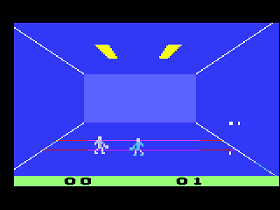 The Game: One or two players try to keep a ball in motion in an enclosed space; standard racquetball rules apply. (Games By Apollo, 1982)
The Game: One or two players try to keep a ball in motion in an enclosed space; standard racquetball rules apply. (Games By Apollo, 1982)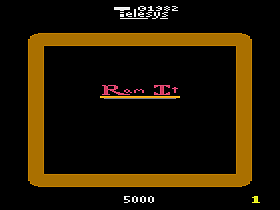 The Game: Controlling the on-screen “ramroid,” you’re up against what appears to be a malevolent bar graph. Your job is to keep the colorful bars from reaching the center of the screen from the left and right sides of the playing field; once they reach the center, you can’t eliminate them unless you’re playing a game variation where they might randomly become flashing “bonus” bars that can be eliminated with a single shot. If two bars meet at the center of the screen, they form an inpenetrable barrier that traps you above or below them. A round ends when the timer runs out (it counts down from 5000), when you’ve eliminated the last oncoming bar from the screen that you can reach, or – preferably – when you completely clear the screen of those bars. (Telesys, 1982)
The Game: Controlling the on-screen “ramroid,” you’re up against what appears to be a malevolent bar graph. Your job is to keep the colorful bars from reaching the center of the screen from the left and right sides of the playing field; once they reach the center, you can’t eliminate them unless you’re playing a game variation where they might randomly become flashing “bonus” bars that can be eliminated with a single shot. If two bars meet at the center of the screen, they form an inpenetrable barrier that traps you above or below them. A round ends when the timer runs out (it counts down from 5000), when you’ve eliminated the last oncoming bar from the screen that you can reach, or – preferably – when you completely clear the screen of those bars. (Telesys, 1982) The Game: You’re guiding a pixellated rendition of famed adventurer Indiana Jones as he embarks on his search for the Lost Ark of the Covenant. Meander through Middle Eastern marketplaces, obtain weapons and items of value, and watch out for snakes as you try to overcome a series of obstacles and hazardous environments, find the clues, and recover the Ark. (Atari, 1982)
The Game: You’re guiding a pixellated rendition of famed adventurer Indiana Jones as he embarks on his search for the Lost Ark of the Covenant. Meander through Middle Eastern marketplaces, obtain weapons and items of value, and watch out for snakes as you try to overcome a series of obstacles and hazardous environments, find the clues, and recover the Ark. (Atari, 1982) The Game: In a bizarre combination of pinball, zero gravity, and nuclear physics, you pilot your “ship” around a reactor chamber, trying to eliminate rogue radioactive particles (which are about the same size as your ship). Anything touching the outer walls of the chamber will be destroyed, including your on-screen alter ego. Two pairs of five rods can be used to cool down the ever-expanding nuclear reaction at the center of the screen, but you can only push the rods in by bumping the particle into them head-on. Trapping particles in either of two cul-de-sacs in the upper right and lower left corners of the playing field will earn you bonus points, and the best way to accomplish this is to plant one of your limited number of decoys at the entrance to one of the smaller areas. In early levels, you can keep your back to the reactor and hug it as you bounce the particles off of it, but in later levels, the reactions are exposed and become just as deadly to you as to the walls are. (Parker Brothers, 1982)
The Game: In a bizarre combination of pinball, zero gravity, and nuclear physics, you pilot your “ship” around a reactor chamber, trying to eliminate rogue radioactive particles (which are about the same size as your ship). Anything touching the outer walls of the chamber will be destroyed, including your on-screen alter ego. Two pairs of five rods can be used to cool down the ever-expanding nuclear reaction at the center of the screen, but you can only push the rods in by bumping the particle into them head-on. Trapping particles in either of two cul-de-sacs in the upper right and lower left corners of the playing field will earn you bonus points, and the best way to accomplish this is to plant one of your limited number of decoys at the entrance to one of the smaller areas. In early levels, you can keep your back to the reactor and hug it as you bounce the particles off of it, but in later levels, the reactions are exposed and become just as deadly to you as to the walls are. (Parker Brothers, 1982)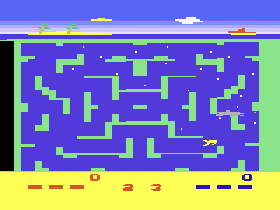 The Game: You’re a deep-sea diver in search of treasure under the ocean. There are only a couple of problems though – there’s a maze made of messy seaweed, which can slow you down or even trap you until you work your way free of it. And if that’s not enough of a problem, these waters are shark-infested, meaning that getting stuck in the path of a finned foe could mean your finish. (Games By Apollo, 1982)
The Game: You’re a deep-sea diver in search of treasure under the ocean. There are only a couple of problems though – there’s a maze made of messy seaweed, which can slow you down or even trap you until you work your way free of it. And if that’s not enough of a problem, these waters are shark-infested, meaning that getting stuck in the path of a finned foe could mean your finish. (Games By Apollo, 1982)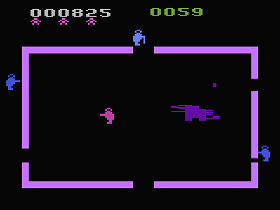 The Game: One man and one hideous mutant creature enter! A bunch of guys peek through holes in the walls and shoot at them! No one leaves! Room Of Doom turns the player into a gladiator, trapped in an enclosed arena with alien creatures. The rules are simple: kill or be killed. The only problem is that it’s always audience participation night: armed guards around the periphery of the arena will open doors at random and fire into the arena. With a well-timed shot before the doors slide shut, the player can do away with these extraneous attackers too. Only by eliminating all of the guards can the player advance to the next level. (Commavid, 1982)
The Game: One man and one hideous mutant creature enter! A bunch of guys peek through holes in the walls and shoot at them! No one leaves! Room Of Doom turns the player into a gladiator, trapped in an enclosed arena with alien creatures. The rules are simple: kill or be killed. The only problem is that it’s always audience participation night: armed guards around the periphery of the arena will open doors at random and fire into the arena. With a well-timed shot before the doors slide shut, the player can do away with these extraneous attackers too. Only by eliminating all of the guards can the player advance to the next level. (Commavid, 1982) The Game: What happens when the Dreaded Dratapillar Of Venus makes a guest appearance? It means that a spelling bee is imminent! A friendly voice warns you to look out for a “monster attack,” and after dispatching all of the segments of the worm-like invader, you’re asked to correctly spell three words using the Odyssey² keyboard. Once you’ve correctly spelled those three words, another monster attack occurs, with the Dratapillar moving faster in each successive level; the game continues until it descends far enough down the screen to reach your cannon. (North American Philips, 1982)
The Game: What happens when the Dreaded Dratapillar Of Venus makes a guest appearance? It means that a spelling bee is imminent! A friendly voice warns you to look out for a “monster attack,” and after dispatching all of the segments of the worm-like invader, you’re asked to correctly spell three words using the Odyssey² keyboard. Once you’ve correctly spelled those three words, another monster attack occurs, with the Dratapillar moving faster in each successive level; the game continues until it descends far enough down the screen to reach your cannon. (North American Philips, 1982) The Game: Armed with a catapult and a seemingly inexhaustible supply of projectiles (sorry, Python fans, no cows!), your task is to repeatedly and continuously smash your opponent’s castle, his catapult (rendering him harmless for a few seconds), or your opponent himself (much the same effect; a new enemy soldier enters the fray after a few seconds). (North American Philips, 1982)
The Game: Armed with a catapult and a seemingly inexhaustible supply of projectiles (sorry, Python fans, no cows!), your task is to repeatedly and continuously smash your opponent’s castle, his catapult (rendering him harmless for a few seconds), or your opponent himself (much the same effect; a new enemy soldier enters the fray after a few seconds). (North American Philips, 1982) The Game: You are an unidentified Smurf en route to save Smurfette from Gargamel’s castle. Now, you may think that Gargamel would deploy his vicious black cat to stop you from reaching that goal, but that sort
The Game: You are an unidentified Smurf en route to save Smurfette from Gargamel’s castle. Now, you may think that Gargamel would deploy his vicious black cat to stop you from reaching that goal, but that sort  The Game: You’re the pilot of a ground-based mobile weapons platform, and there are buttloads of alien meanies headed right for you. Your only defense is a trio of shields which are degraded by any weapons fire – yours or theirs – and a quick trigger finger. Occasionally a mothership zips across the top of the screen. When the screen is cleared of invaders, another wave – faster and more aggressive – appears. When you’re out of “lives,” or when the aliens manage to land on Earth… it’s all over. (Atari, 1982)
The Game: You’re the pilot of a ground-based mobile weapons platform, and there are buttloads of alien meanies headed right for you. Your only defense is a trio of shields which are degraded by any weapons fire – yours or theirs – and a quick trigger finger. Occasionally a mothership zips across the top of the screen. When the screen is cleared of invaders, another wave – faster and more aggressive – appears. When you’re out of “lives,” or when the aliens manage to land on Earth… it’s all over. (Atari, 1982) The Game: Spiders slink down from the top of the screen, constructing an elaborate web and laying eggs as they go. The player, manning a mobile bug-blasting cannon, can take out the spiders, but the eggs are still gestating and will hatch new spiders unless they’re destroyed; new spiders repeat the cycle in rapid succession. Spiders will manage to build their web to the bottom of the screen, restricting the cannon’s movement (and creating zones of the screen where future spider hatchlings can move unimpeded). The game ends when the player loses all of the cannons to the spiders or their incoming fire. (Emerson, 1982)
The Game: Spiders slink down from the top of the screen, constructing an elaborate web and laying eggs as they go. The player, manning a mobile bug-blasting cannon, can take out the spiders, but the eggs are still gestating and will hatch new spiders unless they’re destroyed; new spiders repeat the cycle in rapid succession. Spiders will manage to build their web to the bottom of the screen, restricting the cannon’s movement (and creating zones of the screen where future spider hatchlings can move unimpeded). The game ends when the player loses all of the cannons to the spiders or their incoming fire. (Emerson, 1982) Not wanting to be a casualty of the video game wars, Emerson landed a handful of relatively obscure arcade licenses such as Jungler, Funky Fish and Spiders – none of them exactly household names in the coin-op world. (Most people probably can’t even remember seeing these games in the arcade at all; the author of this review barely remembers seeing Spiders and Jungler in the flesh.) Spiders was actually this vague and abstract in the arcade, too, so it’s really not a bad port, especially on the Arcadia 2001.
Not wanting to be a casualty of the video game wars, Emerson landed a handful of relatively obscure arcade licenses such as Jungler, Funky Fish and Spiders – none of them exactly household names in the coin-op world. (Most people probably can’t even remember seeing these games in the arcade at all; the author of this review barely remembers seeing Spiders and Jungler in the flesh.) Spiders was actually this vague and abstract in the arcade, too, so it’s really not a bad port, especially on the Arcadia 2001. For such an obscure arcade game, Spiders got around; there was also a fairly entertaining Entex tabletop game, though its matrix of fixed graphics made it much more difficult to figure out what was going on. The Arcadia version is fairly faithful to the original, duplicating the utter strangeness of the coin-op original nicely.
For such an obscure arcade game, Spiders got around; there was also a fairly entertaining Entex tabletop game, though its matrix of fixed graphics made it much more difficult to figure out what was going on. The Arcadia version is fairly faithful to the original, duplicating the utter strangeness of the coin-op original nicely.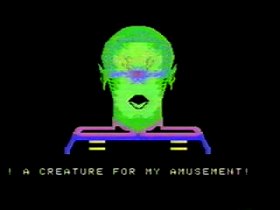 The Game: The Space Fury Commander – a big one-eyed dude with a veiny green cranium – challenges you to a duel. One slight problem: you’ve just got one ship and can only shoot in one direction at a time, and he has a whole battle fleet bent on your destruction. After surviving a round of his contest, you get the chance to dock with an enhancement module that will allow you to fire shots in several directions at once, or fire more powerful shots. The Commander always comes back to taunt you. When you lose all of your ships, the game is over, and one-eye gets to gloat. (Coleco [under license from Sega/Gremlin], 1982)
The Game: The Space Fury Commander – a big one-eyed dude with a veiny green cranium – challenges you to a duel. One slight problem: you’ve just got one ship and can only shoot in one direction at a time, and he has a whole battle fleet bent on your destruction. After surviving a round of his contest, you get the chance to dock with an enhancement module that will allow you to fire shots in several directions at once, or fire more powerful shots. The Commander always comes back to taunt you. When you lose all of your ships, the game is over, and one-eye gets to gloat. (Coleco [under license from Sega/Gremlin], 1982)
 The Game: Players control a spy sneaking through a building looking for secret information. High-speed elevators zoom up and down their cables throughout each floor at random intervals, making it difficult to accomplish the goal of crossing to the other side of the screen (the only way to ascend to the next floor). It takes skill, timing and nerves of steel to keep one’s spies from their demise. (Penguin Software, 1982)
The Game: Players control a spy sneaking through a building looking for secret information. High-speed elevators zoom up and down their cables throughout each floor at random intervals, making it difficult to accomplish the goal of crossing to the other side of the screen (the only way to ascend to the next floor). It takes skill, timing and nerves of steel to keep one’s spies from their demise. (Penguin Software, 1982)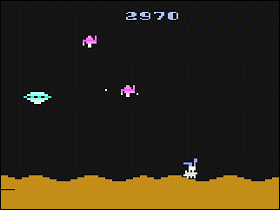 The Game: Space is a dangerous place, full of enemy fighters, hostile vehicles…and even enemy biplanes and enemy hot air balloons. Your job? Blow ’em all away. Your space fighter can hug the ground or zip into the stratosphere in a second, which is good because there are oncoming enemies at every altitude. If they take out all of your fighters, you might as well kiss the planet goodbye…which is kind of embarrassing if this means you’ve left the world open to invasion by balloon. (Vidtec [U.S. Games], 1982)
The Game: Space is a dangerous place, full of enemy fighters, hostile vehicles…and even enemy biplanes and enemy hot air balloons. Your job? Blow ’em all away. Your space fighter can hug the ground or zip into the stratosphere in a second, which is good because there are oncoming enemies at every altitude. If they take out all of your fighters, you might as well kiss the planet goodbye…which is kind of embarrassing if this means you’ve left the world open to invasion by balloon. (Vidtec [U.S. Games], 1982)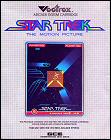 The Game: You’re at the helm of the U.S.S. Enterprise – that’s the cool part. The not-so-cool part? You’re in disputed territory – and the Klingons are bringing the fight to you en masse, attacking both the Enterprise and local Starbases, which you have the defend (lest you be left with no place to refuel). Use your phasers, photon torpedoes and shields judiciously – and do whatever it takes to halt the Klingon advance before they overrun Federation space. (GCE, 1982)
The Game: You’re at the helm of the U.S.S. Enterprise – that’s the cool part. The not-so-cool part? You’re in disputed territory – and the Klingons are bringing the fight to you en masse, attacking both the Enterprise and local Starbases, which you have the defend (lest you be left with no place to refuel). Use your phasers, photon torpedoes and shields judiciously – and do whatever it takes to halt the Klingon advance before they overrun Federation space. (GCE, 1982)
